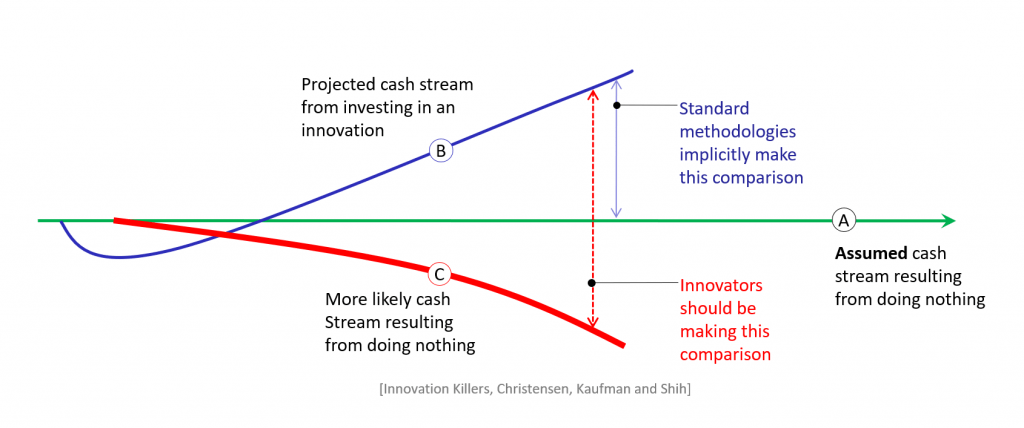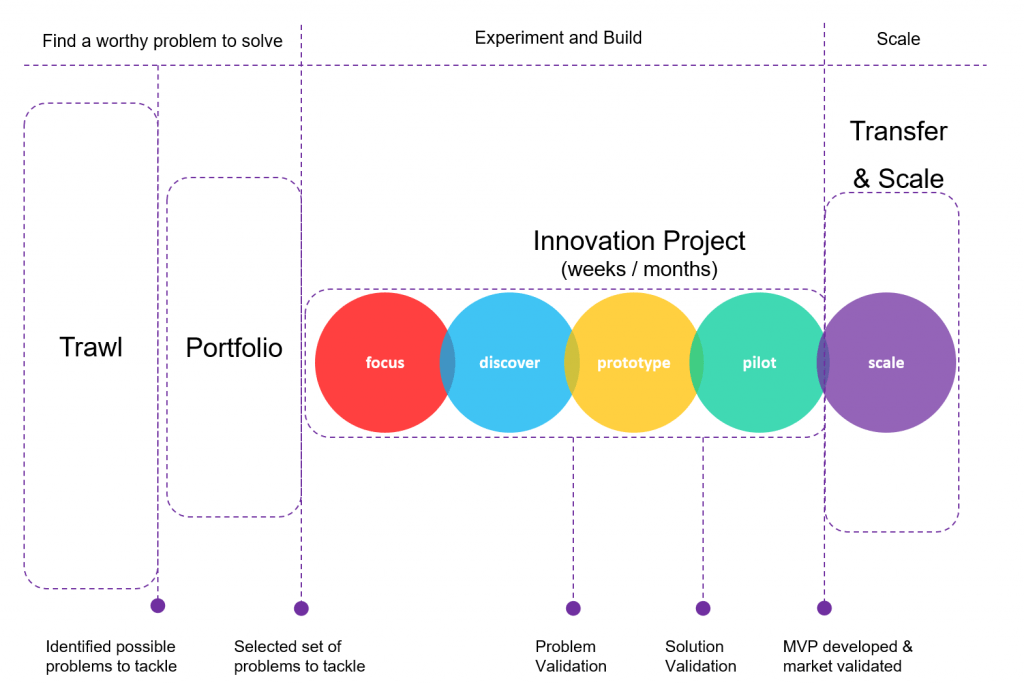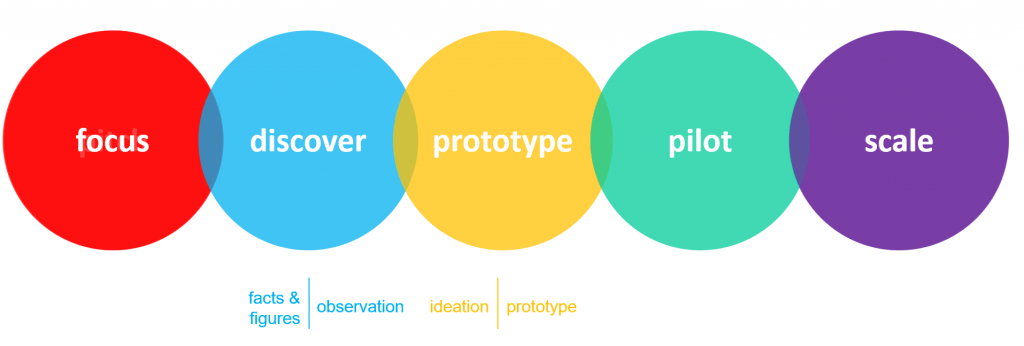Corporates are what successful start-ups become when they grow-up. They transform from feisty teenagers ready to take on and change the world into conservative middle-agers protecting their investments and not wanting to rock the boat. While start-ups search for new radical business models to disrupt, corporates are organised to execute a successful business model with utmost efficiency. They are optimised to deliver repeatable products, revenue and profits. Corporate culture is dominated by processes, procedures and incentives to improve the current business model. When you have so much to protect it can be hard to take the risk to innovate. And more often than not, it seems safer to follow known processes and procedures to maintain the efficiency of the existing machine.
The “Do-Nothing Fallacy”
Many executives assume – incorrectly – that the present health of the company will persist indefinitely without investing in innovation. As Christensen, Kaufman and Shih explain in their HBR article “Innovation Killers,” it’s tempting but wrong to assess the value of a proposed innovation investment by measuring whether it will make us better off than we are now. This creates an anti-innovation bias: you need to take the future into account.
A key error is to assume that the current situation – the do-nothing scenario – against which cash flows from the innovation are compared, will continue to be healthy. In most situations the corporation does not operate in isolation and their competitors will continue to innovate putting pressure on market share, margins and relevance to their customers – causing declining value over time. The potential of future innovation is more accurately calculated when compared to the likely declining revenue of the do-nothing scenario.
The Do-Nothing Fallacy
As Gary Hamel states, “In a world of ever-accelerating change, innovation is the only insurance against irrelevance.”
Innovation frameworks help corporations innovate
Corporate leaders need to believe and understand that innovation is essential for survival and sustained growth. Innovation needs to be unambiguously evident within a customer-centric vision and mission. The mission should inspire and demand innovation to reach ambitious corporate goals. And these goals should influence every other choice within the company. Companies should take steps to identify and refine their critical innovation goals. This will ensure clarity in focusing on successful strategies and help align the company focus and effort.
The Innovation framework below is a useful tool to help organise innovation.
The Innovation Framework
Once you have your strategy the next key question is “where to play”? There are a number of useful frameworks to “trawl” for innovation opportunities, they include:
- Find the Future First: Use integrated trend analysis to spot unnoticed patterns of trends that can substantially change the rules of the game: including technology, alternative commercial models, and new customer usage models and expectations.
- Challenge the Orthodoxies: Question deeply held dogmas and beliefs of your industry and company about what drives success.
- Strategic Resources: Think of your company as a portfolio of competencies, relationships and assets rather than as a provider of products or services for specific markets. Figure out how to integrate, recombine and mash these up in different ways to provide new value and new solutions.
- Deep Customer Insights: Invent successful solutions by learning to live inside your customer’s skin and identifying their unarticulated and unmet needs.
A comprehensive innovation trawl typically yields more opportunities than can be tackled – you can do many things, but you can’t do everything. Carefully evaluate and select opportunity areas that align to your mission and identify an unmet need for your customer that you believe can be solved in a unique and novel way. Generate a portfolio of innovation opportunities that match your risk appetite and your ROI timelines. These opportunities become the innovation projects to execute against.
There is a view that innovation is chaotic and unpredictable and therefore does not need a framework. However, because it is chaotic and unpredictable – and it is – this is precisely why an innovation framework that tackles challenges in a systematic manner is extremely valuable. Innovation ventures already have enough risk, with many factors beyond the team’s control. Using an innovation framework helps by reducing risk factors that you can control. The framework can help you succeed, or it can help you fail faster if failure was inevitable for the path you were on, thus avoiding wasted effort and investment.
Innovation Projects
Once a portfolio of innovation projects has been generated they need to be executed using an “Innovation Methodology.” An innovation project typically has a considerable amount of uncertainty at the beginning with many more unknowns than knowns. A useful methodology to execute innovation projects is “Design Thinking,” popularised by the leading design and innovation firm IDEO and further researched and extended at the Stanford d.school, among others. Design thinking uses a customer centric approach to deeply understand a problem area from the customer perspective. Once identified, these unmet and poorly articulated needs can be solved in new and novel ways.
Design Thinking Methodology
The key steps in the Design Thinking methodology are:
- Focus: This is the starting point – it can be an idea, a technology or a passion. This is your initial hunch and should capture your thoughts and aspirations by using an innovation brief.
- Discover: In this phase, you deep dive to better understand the challenge space. Conduct a holistic exploration of the current situation by using available quantifiable data to understand key fact patterns – a left brain activity. Once completed, it’s important to “get out of the office” and find your customer to observe, interview and deeply understand their context. From this you should be able to identify the real unmet needs and struggles they face – a right brain activity. This “left brain, right brain” approach should yield a better, clearer understanding of the actual challenge.
- Prototype: In this step you generate many ideas to tackle the challenge, cluster those ideas into concepts and prototype and test them directly with customers. Review learnings and iterate until you’ve figured out the right product or service to design.
- Pilot: Specify and develop a minimum viable product (MVP) to achieve three objectives: 1) give your customer a minimum version of the solution to quantify the value proposition, 2) have the customer pay for the product so you’re validating the willingness of the customer to purchase your product, and 3) develop a higher fidelity level of feedback from the customer / end-user. Finally, conduct a restricted “in market” test to fully validate if the solution will work for your initial target market.
- Scale: Once the MVP has been validated, develop a version 1.0 solution which you scale and win in your initial market. At this point, you should also describe how the product will be improved and refined over the next several versions so that it can fully capture your initial market and then start to address follow-on markets.
Summary:
Corporates must innovate. Innovation is imperative for customer relevance, company growth, and ultimately, survival. The challenge for a corporate is how to innovate within a culture and system designed to optimise the existing successful business model. This doesn’t mean that corporates don’t have the resources and the capability to innovate. To unlock this future potential the leadership must drive and demand innovation, with the necessary follow-through for success. By using an overarching innovation framework and execution methodology, leadership can de-risk the effort for maximum learning and steer an ultimately commercially successful outcome. Innovation requires an organisation design that mandates and supports the innovation framework – upfront innovation trawling, portfolio generation, discovery and prototyping – to identify and validate high potential opportunities. To achieve this many corporates create Innovation Labs – the topic of a future blog.
To learn more about our Corporate Innovation programs click here.
Are you a startup? Join one of our accelerators and gain innovative Design Thinking skills!
International Mentor Group to KAUST Entrepreneurship Centre & Kradyl
Jim’s mission at Kradyl is to help build the most innovative and design centric organisations. He is infusing and enabling a culture of meaningful customer-centric innovation and design across a wide range of organisation to help them engage customers and inspire the future. As Innovation Director, Jim co-founded the Intel and Citibank innovation centres and recently helped establish the Accenture Global Centre for Innovation. Over his 30+ year career, Jim has led all design and innovation aspects of a company including, product and service design, experience design, manufacturing process design, customer discovery, organisation design, business strategy and culture. He has designed, manufactured and launched physical and digital products, experiences, manufacturing processes, and organisations across multi-national corporations, small businesses and start-ups. He has Engineering and Maths degrees, and an IT in Education Masters from Trinity College Dublin.





